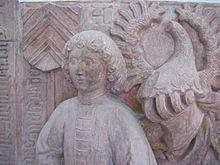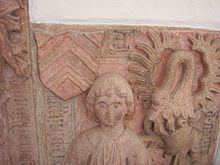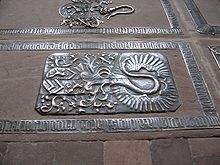Philip I (Hanau-Lichtenberg)
Philipp I (the elder) of Hanau-Lichtenberg (born November 8, 1417 in Windecken ; † May 10, 1480 in Ingweiler , today: Ingwiller) was Count of Hanau and ruled after a division of the country between him and his nephew, Count Philipp I. . (the younger one) , the Hanau-Lichtenberg region.
The time before the division of the country
Philipp I (the elder) of Hanau was born on November 8, 1417 at Windecken Castle as the son of Reinhard II of Hanau, who later became count, and his wife, Katharina von Nassau-Beilstein , and was baptized there two days later. Godparents were Johann Trier, Commander of the Teutonic Order in Frankfurt , and Gertrud (also called Gela) von Kronberg , daughter of Frank X. von Kronberg (1381–1423) and Gertrud von Hatzfeld (1381–1409), who was married to her second time Philipp von Frankenstein († 1433).
| Pedigree of Count Philipp I of Hanau-Lichtenberg | ||||||
|---|---|---|---|---|---|---|
| Great grandparents |
Ulrich III. von Hanau (* 1310; † 1370) |
Eberhard von Wertheim († 1373) |
Heinrich I. v. Nassau-Beilstein († 1378/80) ∞ |
Arnold von Randerode |
||
| Grandparents |
Ulrich IV. Von Hanau (* approx. 1330; † 1380) |
Heinrich II of Nassau-Beilstein († 1412) |
||||
| parents |
Reinhard II. Von Hanau (* 1369; † 1451) |
|||||
|
Philip I (the elder) |
||||||
For the family cf. Main article: Hanau (noble family)
Originally a spiritual career was planned for Philipp as a later son. But this did not happen for unknown reasons. Rather, we find him engaged in a military career in the mid-15th century. In 1448 he is in the camp of the Duke of Cleve during his dispute with the Archbishop of Cologne . In 1451 his father died. He was succeeded by his brother, Count Reinhard III.
Division of the country
initial situation
In 1452 Count Reinhard III died after only one year of reign. Heir was his son, the only four-year-old Philipp "the younger" .
The fact that a four-year-old inherited the county brought the family into conflict:
- Either the primogeniture to be observed in the Hanau house since 1375 was followed. This meant to wait and see whether Philip I the Younger reached adulthood, fathered offspring, and continued the dynasty. This had the advantage that the family's property was kept in one hand. But it had the disadvantage that should Philip the Younger die without heirs entitled to inherit, the dynasty would die out.
- Or the family disregarded the primogeniture law and allowed the next agnate , Philip I the Elder, to marry. This had the advantage of significantly increasing the chances of the dynasty's survival, but the disadvantage that the county had to be divided for this purpose. Time was of the essence for this model too. Philip the Elder was almost 40 years old at the time.
Fight for division
The dispute over the division of the county is relatively well documented. Parties formed in the county and in the ruling family. For Philip the Younger there was a guardianship due to his minority . This was first noticed by his maternal grandfather, Count Palatine Otto I von Pfalz-Mosbach , his paternal grandmother, Katharina von Nassau-Beilstein , and his uncle, Philipp the Elder. This applies to the time before and during the division of the country. After that Philip the Elder was appointed sole guardian. Philip the Younger came of age in 1467.
The party that represented the interests of Philip the Elder was initially left behind. Count Palatine Otto I. von Pfalz-Mosbach was against the division. He supported the position of his daughter Margarethe , the widow of Reinhard III. and mother of Philip the Younger. He tried to maintain the position of his grandson as the sole heir and family owner in the county of Hanau.
The older countess widow, Katharina von Nassau-Beilstein, on the other hand, couldn't care less whether her second-born son, Philip the Elder. or her grandson, Philip the Younger, continued the line. She estimated the danger for the existence of the Hanau family to be lower if the proven fatherable Philip the elder were allowed to marry as soon as possible, instead of relying solely on the child Philip the younger.
The party of Philip the Elder therefore organized a coordinated action of all relatives of the count's family, the most important cooperations of their subjects - above all the four cities of the County of Hanau , Windecken, Babenhausen and Steinau - the associations of the Burgmanns of Burg Babenhausen and the Palatinate Gelnhausen and the vassals of Count von Hanau, who all wrote to Count Palatine Otto I and asked that he, too, consent to a marriage of Philip the Elder. The letters are kept in the Hessian State Archives in Marburg .
Partition treaty of 1458
When his daughter Margarethe died in 1457, Count Palatine Otto I lost interest in preventing the division. The risk assessment was therefore in favor of a marriage of Philip the Elder and a division of the country. Immediately, as early as January 1458, a family contract was sealed that granted all parts of the county that lay south of the Main , especially the offices of Babenhausen and the Hanau share in the Umstadt condominium , to Philip the Elder. The disadvantage of a division of the county was alleviated by the fact that Philip the Elder did not simply receive half of the county, but only the mentioned, much smaller parts. The family contract also gave him the right to marry, which he made use of in the same year. In each of the sub-counties, in turn, the primogeniture should apply from now on .
In retrospect, the decision was correct, not because Philip the Younger had died prematurely, but because Philip the Elder and his descendants managed to form their own handsome county, the County of Hanau-Lichtenberg , through advantageous marriages . The rest of the territory, which represented the majority of the County of Hanau, remained with Philip the Younger.
designation
In order to distinguish the two Hanau counties, the part that was ruled by Philip the Elder was named after the Lichtenberg inheritance in 1480 as the county of Hanau-Lichtenberg. For the part of the county that was ruled by Philip the Younger, the county of Hanau-Münzenberg has been officially spoken of since 1496 . In order to be able to differentiate between the two counties and their regents between 1458 and these dates, the names Grafschaft Hanau-Münzenberg and Grafschaft Hanau-Lichtenberg have been used consistently since 1458.
family
Philip the Elder married on September 6, 1458 in Hanau Anna von Lichtenberg , (* October 25, 1442; † January 24, 1474) heir daughter of the Lichtenberg rule . Their children together were:
- Johann (* approx. 1460; † September 4, 1473), buried in the town church of St. Nikolaus in Babenhausen
- Philip II (born May 31, 1462 in Hanau, † August 22, 1504 in Babenhausen)
- Margarethe (* May 15, 1463, Lichtenberg; † May 26, 1504), married to Count Adolf III. from Nassau-Idstein-Wiesbaden
- Ludwig von Hanau-Lichtenberg (* 23 August 1464; † 30 December 1484, Trient )
- Anna († 1491), nun in the Marienborn monastery
- Dieter (approx. 1468; † February 25, 1473), buried in the town church of St. Nicholas in Babenhausen. In addition to his epitaph in the town church of Babenhausen, there is also a representation of him on a stained glass window from the chapel of his grandfather, Ludwig V von Lichtenberg , which is now in the Badisches Landesmuseum in Karlsruhe .
- Albrecht (* before 1474; † June 24, 1491), buried in Buchsweiler
In addition, Philip had at least one extramarital relationship, with whom it is not recorded, from which or from which children also emerged:
- Johann von Hanau-Lichtenberg (life dates not known, mentioned 1463) was a clergyman. Since in 1463 he asked for the papal dispensation to take up a pastor's position at the altar of Saint George in Orffal (l), a desert west of Erfurt , it probably came from a premarital union of his father, who until the division of the County of Hanau in 1458, the Marriage first allowed him to live unmarried. His mother's name is not known.
- Reinhard Hanauer (life dates not known, mentioned 1512), provost of Neuweiler .
government
First Philip the Elder took over the sole guardianship of his nephew, Philip the Younger, after 1458. The counties remained united until he came of age in 1467. Philipp the Elder then resided in the castle in Babenhausen, which he expanded for himself and his family. In 1460 the east wing was built.
One finds him in these years with dynastic-political activities with Landgrave Heinrich III. of Hesse, Elector Friedrich I , of the Palatinate, the Count of Henneberg and with Elector Ruprecht of Cologne from the house of the Electors of the Palatinate.
In 1468 he determined, following the primogeniture requirement from the partition contract of 1458 for his sub-county, that only one of his sons should remain secular.
Militarily, he participated in the conflicts between the Holy Roman Empire and France over Burgundy on the side of Emperor Frederick III. and in a campaign against the Turks.
In 1480 he inherited one half of the Lichtenberg estate, mostly in Alsace , for his children through his pre-deceased wife with the death of her childless uncle, Jakob von Lichtenberg , as well as her sister, who was married to Count Simon Wecker von Zweibrücken . This gain made the until then modest county of Hanau-Babenhausen a county comparable to the Munzenberg region. The Zimmerische Chronik commented on the inheritance as follows: "The barons of Liechtenberg in Elsäs were in a great respect and power, that may well be lost in our times with the great goods from which the two families Bitsch and Hanow became rich."
death
Philip the Elder died on May 10, 1480, just one day after signing the partition agreement with Count Simon Wecker von Zweibrücken. He was buried in the town church of St. Nikolaus in Babenhausen. The epitaphs from him, his wife and two sons died early of red sandstone have survived, in addition, other representations: On the St. Adelphus -Teppichen that in Peter and Paul's Church in Neuwiller-lès-Saverne in Alsace are kept , and on a stained glass window of the chapel of the dead, his father-in-law, Ludwig V, from the same church that is now in the Baden State Museum.
literature
- Reinhard Dietrich : The state constitution in the Hanauischen = Hanauer Geschichtsblätter 34. Hanau 1996. ISBN 3-9801933-6-5
- Reinhard Dietrich: Hanau bastards . In: New magazine for Hanau history (messages from the Hanauer Geschichtsverein 1844 eV) 2015, pp. 25–34. * Paul-Joachim Heinig: Kaiser Friedrich III. and Hessen . In: Hessisches Jahrbuch für Landesgeschichte 32. S. 63 ff.
- JG Lehmann: Documented history of the county Hanau-Lichtenberg in the lower Alsace . 2 vol., O. O. 1862 (?). ND Pirmasens 1970.
- Alfred Matt: Le mariage de Philippe I de Hanau Avec Anne de Lichtenberg or “La naissance d'un Comté” . In: Société d'Histoire et d'Archaeologie de Saverne et Environs (Eds.): Cinquième centenaire de la création du Comté de Hanau-Lichtenberg 1480 - 1980 = Pays d'Alsace 111/112 (2, 3/1980), p 47-49.
- Gisela Probst: The Memoria of the Lords of Lichtenberg in Neuweiler (Alsace). Adelphus carpets, high grave of Ludwig V († 1471), holy grave (1478), glass paintings = new research on German art XI. Berlin 2015. ISBN 978-3-87157-241-8
- Sebastian Scholz : The "Eternal Adoration" of Philip I of Hanau-Lichtenberg and his family. Forms of expression of aristocratic memoria and piety in the late Middle Ages . In: Contributions to the history of the County of Hanau-Lichtenberg. Published for the 20th anniversary of the partnership between the two former royal residence cities of Babenhausen and Bouxwiller = Babenhausen once and now 31 (2004), p. 19ff.
- Sebastian Scholz: The inscriptions of the city of Darmstadt and the districts of Darmstadt-Dieburg and Groß-Gerau = The German inscriptions vol. 49 = Mainz series vol. 6. Ed. of the Academy of Sciences in Mainz. Wiesbaden 1999.
- Reinhard Suchier : Genealogy of the Hanauer count house . In: Festschrift of the Hanau History Association for its 50th anniversary celebration on August 27, 1894 . Hanau 1894.
- Ernst Julius Zimmermann : Hanau city and country . 3rd edition, Hanau 1919. ND 1978.
References
- ↑ Philip the Elder already had at least one illegitimate son, Johann von Hanau-Lichtenberg .
- ↑ Until then, Philipp the Elder should actually have been called von Hanau-Babenhausen, but that never caught on in literature.
- ^ Deviating March 3, 1474: Scholz: Insschriften , p. 67, no. 4.
- ^ Probst, p. 193.
- ↑ a b Dietrich: Bastarde , p. 26.
- ↑ Volume 1, p. 467
- ↑ Scholz: Eternal Adoration .
- ^ Propst, pp. 87, 192.
| predecessor | Office | successor |
|---|---|---|
| Philip I the Younger |
Count of Hanau-Lichtenberg 1458–1480 |
Philip II |
| personal data | |
|---|---|
| SURNAME | Philip I. |
| ALTERNATIVE NAMES | Philip I the Elder; Hanau-Lichtenberg, Philipp von |
| BRIEF DESCRIPTION | Count of Hanau-Lichtenberg |
| DATE OF BIRTH | November 8, 1417 |
| PLACE OF BIRTH | Wind corners |
| DATE OF DEATH | May 10, 1480 |
| Place of death | Ingweiler |





